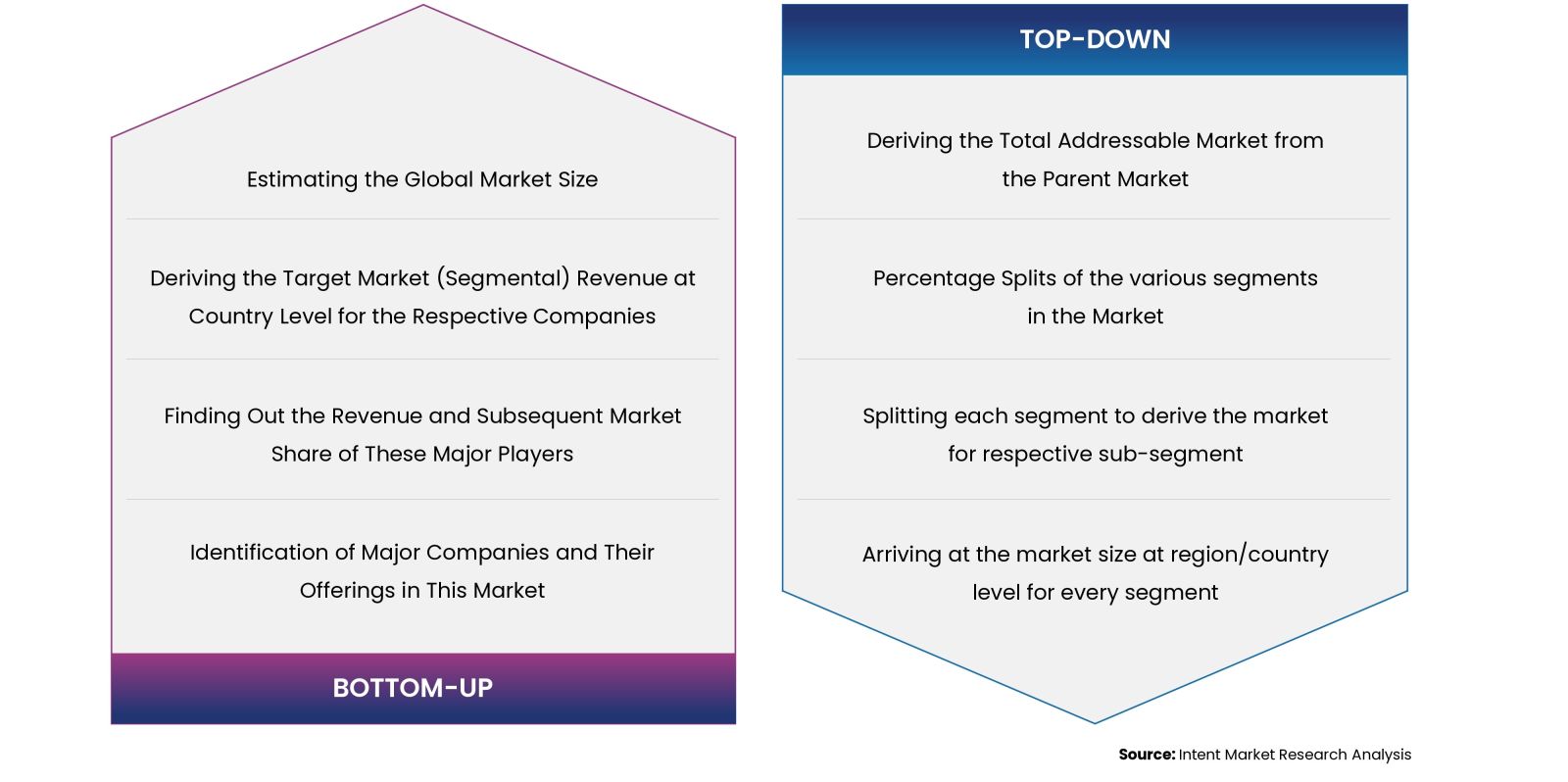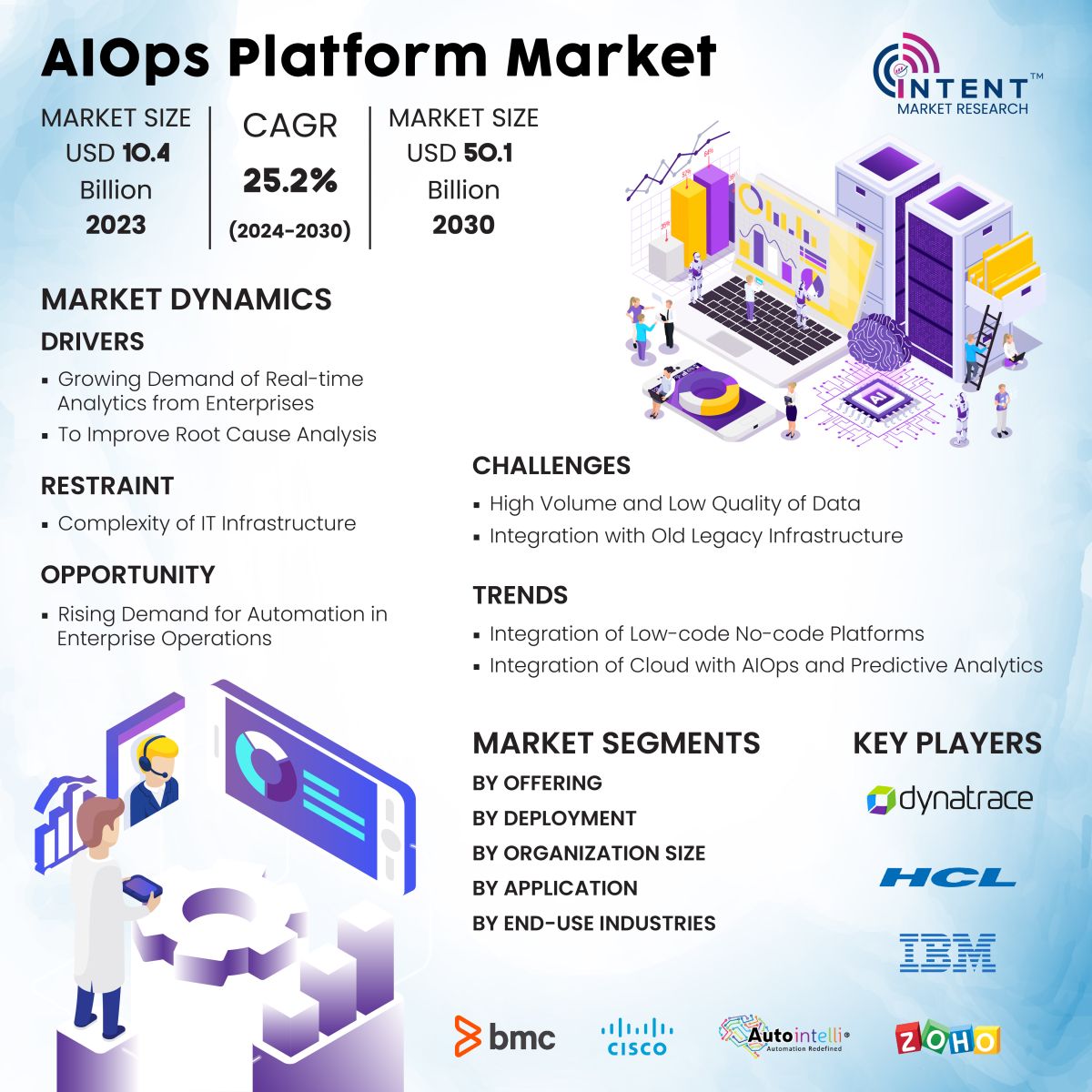The AIOps Platform Market is expected to grow from USD 10.4 billion in 2023-e to USD 50.1 billion by 2030, at a CAGR of 25.2% during the forecast period. The AIOps platform market is a competitive market, the prominent players in the global market include BMC Software, Broadcom, Cisco, Dynatrace, HCL, IBM, Interlink Software, Micro Focus, Moogsoft, NTT Data, OpenText, SolarWinds, and Splunk. Additionally, Autointelli, BigPanda, CloudFabrix, ManageEngine, Netreo, New Relic, PagerDuty, ProphetStor, Resolve, Sumo Logic, and Zoho are the emerging companies of the market.
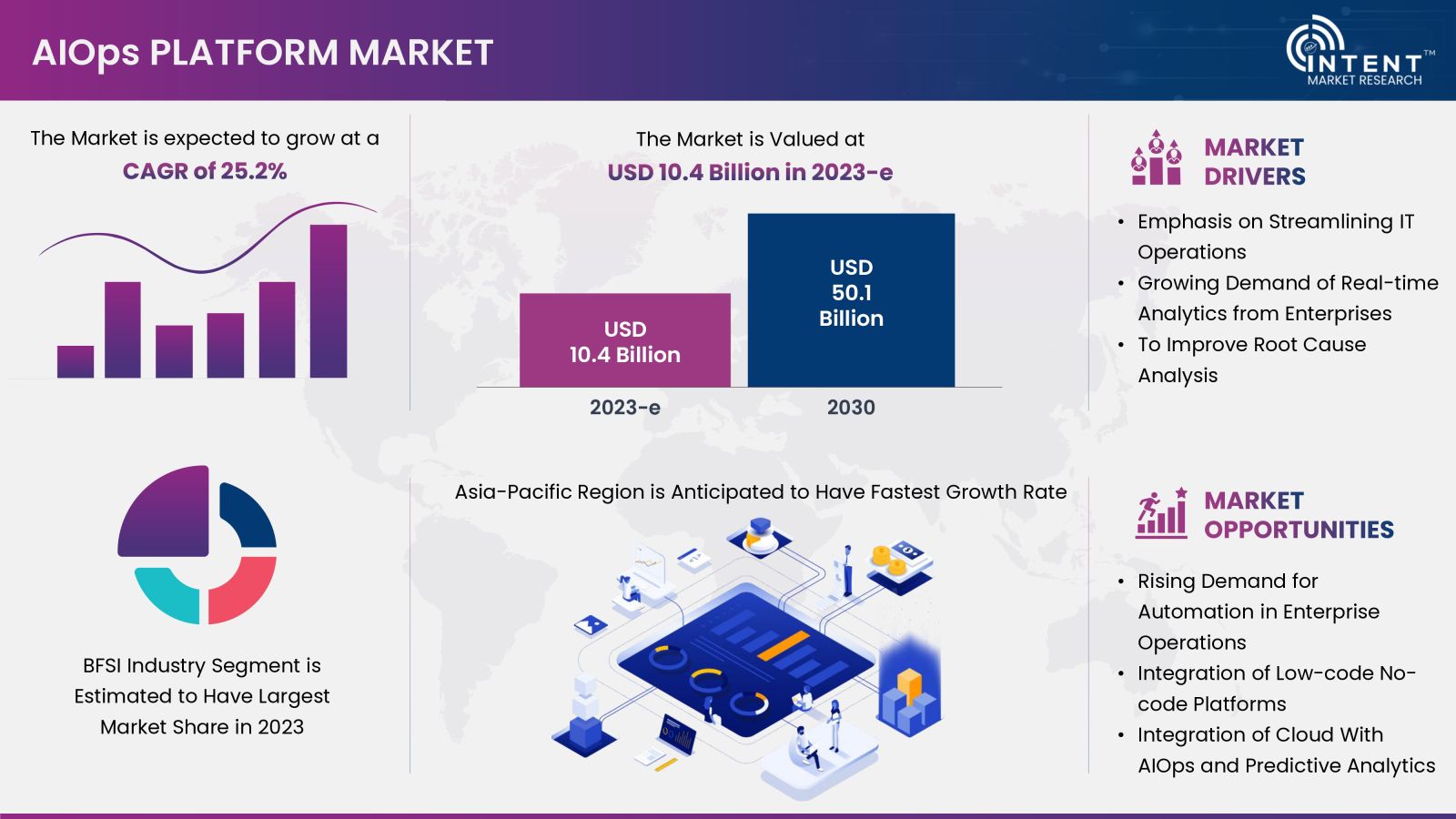
Click here to: Get FREE Sample Pages of this Report
AIOps stands for Artificial Intelligence for IT Operations. It is advanced analytics including machine learning and AI to monitor and manage the performance and reliability of applications and hardware systems, detect anomalous problems, adapt to changes in load, handle failures, and proactively or rapidly adjust with no or minimal disruption of services. Other names for AIOps are IT operations analytics (ITOA), advanced operational analytics, AI for ITOM, IT data analytics, and Cognitive Operations.
AIOps is the multi-layered use of big data analytics and machine learning applied to IT operations data. The goal is to automate IT operations, intelligently identify patterns, augment common processes and tasks, and resolve IT issues. AIOps brings together service management, performance management, event management, and automation to realize continuous insights and improvement.
Emphasis on Streamlining IT Operations Driving the Adoption of AIOps Platform
AIOps leverages artificial intelligence (AI) and machine learning (ML) to enhance and automate various aspects of IT operations, contributing to increased efficiency, faster incident resolution, and improved overall performance. AIOps platforms use advanced analytics and pattern recognition to detect anomalies and potential issues in real-time. This helps in proactively identifying and resolving incidents before they impact the system or end-users.
AIOps tools continuously monitor the performance of IT infrastructure and applications. By analyzing historical data and patterns, these platforms can provide insights that help optimize resource allocation and prevent performance bottlenecks. AIOps platforms provide continuous monitoring of IT environments and adapt to changes dynamically. This ensures that operations remain efficient even as the IT landscape evolves.
By optimizing resource allocation, preventing downtime, and automating routine tasks, AIOps contributes to cost savings for organizations. Considering the potential benefits of integration of AIOps, an increasing number of enterprises are adopting the AIOps platform, thereby driving the global market.
AIOps Platform Market Segment Insights
High Demand for Domain-centric AIOps Platform Driving the Market
Domain-centric AIOps is the application of AIOps to solve problems within a certain domain. This type of platform focuses on homogenous, first-party datasets and offers AI capabilities to solve specific business use cases, such as network and application diagnostics. It can be customized to align with industry-specific workflows and processes. This customization ensures that the AIOps solution integrates seamlessly with existing tools and practices within a particular domain.
Certain industries, such as finance, healthcare, and government, have strict compliance and regulatory requirements. Domain-centric AIOps solutions can be designed to meet these specific standards, providing organizations with confidence in their adherence to industry regulations. These advantages have promoted the adoption of domain-centric AIOps platforms in the market.
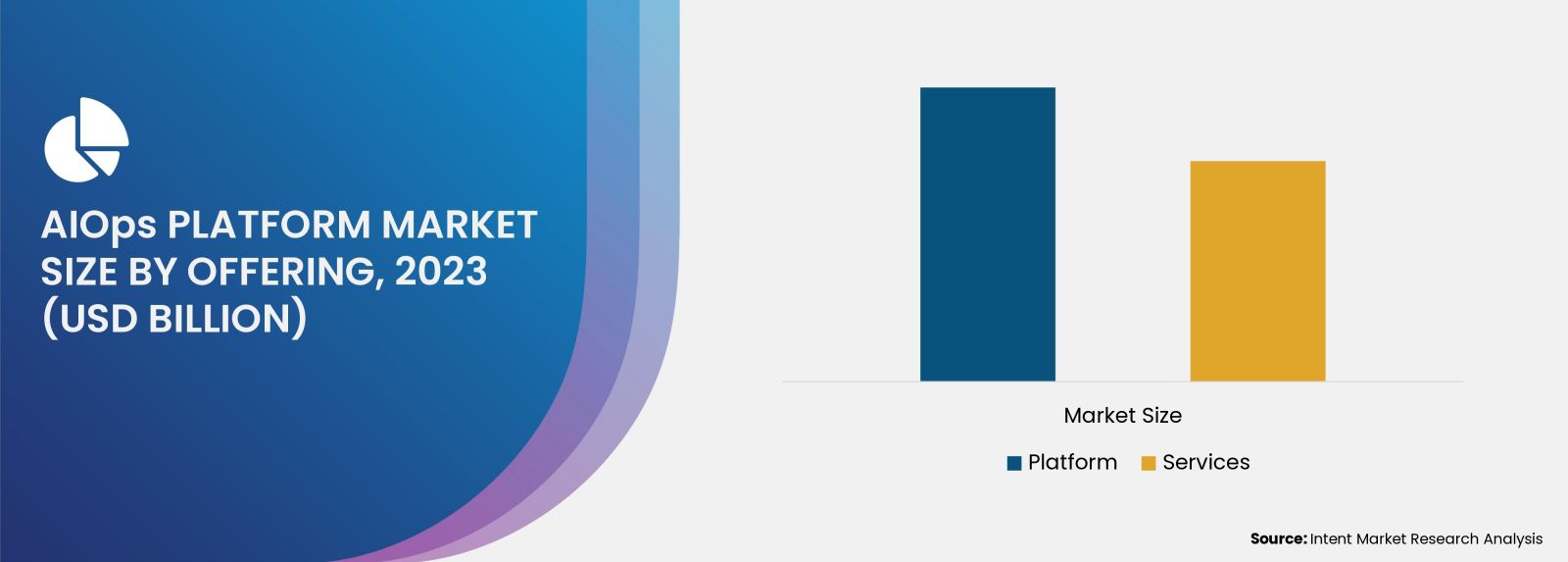
Large Enterprises Dominating the Deployment Segment
Large enterprises typically operate at a massive scale with complex and diverse IT infrastructures. AIOps platforms can handle the scale and complexity by automating tasks, providing insights, and enabling efficient management of vast amounts of data and systems. Large enterprises deal with a multitude of routine and repetitive tasks in their IT operations. AIOps platforms automate these tasks, freeing up IT staff to focus on more strategic initiatives, innovation, and complex problem-solving.
As large enterprises grow and evolve, their IT infrastructure needs to scale accordingly. AIOps platforms are designed to be scalable, allowing them to adapt to the increasing volume and complexity of data and systems that large enterprises manage. Large enterprises captured the major share of the global market in 2023.
On-premise Segment Expected to Lead the Deployment Segment
On-premise AIOps platforms offer a solution that aligns with regulatory requirements while still providing the benefits of AI-driven IT operations. On-premise AIOps platforms provide a solution that allows organizations to leverage AI for IT operations while maintaining control over their data. On-premise solutions offer a high level of customization and control over the deployment. Organizations can tailor the AIOps platform to fit their specific needs, integrate it seamlessly with existing on-premise systems, and have greater control over updates and configurations.
Real-time Analytics Expected to Show Significant Share
Real-time analytics enable AIOps platforms to detect anomalies and potential issues as they occur. This proactive approach allows IT teams to identify and address problems before they escalate, minimizing downtime and service disruptions. Real-time analytics provide immediate insights into the performance and health of IT systems. This enables IT teams to respond swiftly to incidents, reducing resolution times and ensuring a faster recovery from disruptions.
Real-time analytics play a crucial role in triggering automation workflows in response to specific events or conditions. Automation can be initiated promptly based on real-time insights, improving the efficiency of routine tasks and incident resolution. Real-time analytics contribute to operational intelligence by providing actionable insights into system performance, resource utilization, and application behavior. This intelligence helps IT teams make informed decisions in real time. In 2023, the real-time analytics segment is estimated to account for a significant share of the market.
BFSI to Capture the Major Share of the Market
The BFSI sector typically operates complex and distributed IT infrastructures that include a wide range of applications, databases, networks, and third-party services. AIOps helps to manage this complexity by providing real-time insights, proactive issue detection, and automated responses to incidents. The BFSI sector is heavily regulated, with stringent compliance requirements related to data security, privacy, and operational standards. AIOps platforms can assist in ensuring compliance by providing real-time monitoring, audit trails, and automated responses to potential compliance violations.
AIOps platforms can employ advanced analytics and machine learning to detect patterns indicative of fraudulent activities. Real-time analysis of transaction data and user behavior helps in identifying anomalies and potential fraud, allowing for swift intervention. AIOps help in optimizing resource utilization and reduce operational costs by automating routine tasks and preventing downtime. This is particularly important in the BFSI sector, where efficient operations directly impact the bottom line.
Asia-Pacific to Grow Exponentially in the Coming Years
Asia-Pacific has been witnessing a rapid expansion of IT infrastructure, including cloud adoption, data center growth, and increased connectivity. AIOps is well-suited to manage the complexity and scale of modern IT environments, making it a valuable solution for organizations in the region. Asia-Pacific is home to a diverse range of industries, including finance, healthcare, manufacturing, e-commerce, and more. AIOps adoption is expected to grow across these verticals as organizations seek to enhance operational efficiency, optimize performance, and drive innovation.
The Asia-Pacific region has a growing pool of skilled IT professionals and technology talent. This availability of talent can facilitate the adoption and implementation of AIOps solutions by organizations in the region thereby driving regional share in global AIOps platform market.
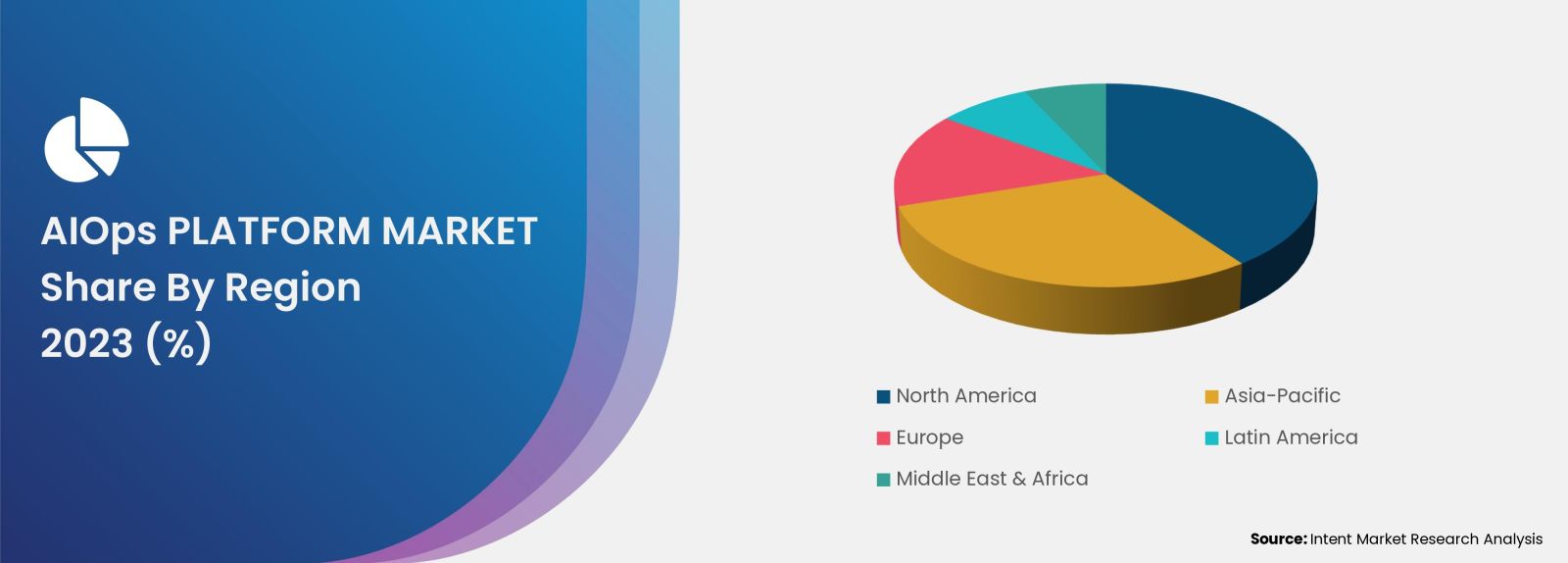
Major Industry Players are Enhancing their Market Positions By Adopting Several Growth Strategies
Major players operating in the global AIOps platform market are BMC Software, Broadcom, Cisco, Dynatrace, Elastic, HCL, IBM, Interlink Software, Micro Focus, Moogsoft, NTT Data, OpenText, and SolarWinds. Additionally, Autointelli, BigPanda, CloudFabrix, ManageEngine, Netreo, New Relic, PagerDuty, ProphetStor, Resolve, Sumo Logic, and Zoho are emerging companies in the market.
To tap the potential share of the market, major players have started adopting strategies such as new product launches, mergers & acquisitions, partnerships & collaboration. Some of the significant developments are mentioned below
- In November 2023, BMC announced new AIOps capabilities for the BMC Helix Operations Management solution using its BMC HelixGPT capability. The BMC Helix Operations Management solution transforms IT operations with out-of-the-box service blueprints for dynamic service modeling, easy-to-read situation explainability, and situation fingerprinting to remember similar situations.
- In June 2023, Cisco announced the launch of a new Full-Stack Observability Platform, a vendor-agnostic solution that harnesses the power of the company's full portfolio. It delivers contextual, correlated, and predictive insights that allow customers to resolve issues more quickly and optimize experiences, while also minimizing business risk.
Click here to: Get your custom research report today
AIOps Platform Market Coverage
The report provides key insights into the AIOps Platform market, and it focuses on technological developments, trends, and initiatives taken by the government and private players. It delves into market drivers, restraints, opportunities, and challenges that are impacting market growth. It analyses key players as well as the competitive landscape within the global market.
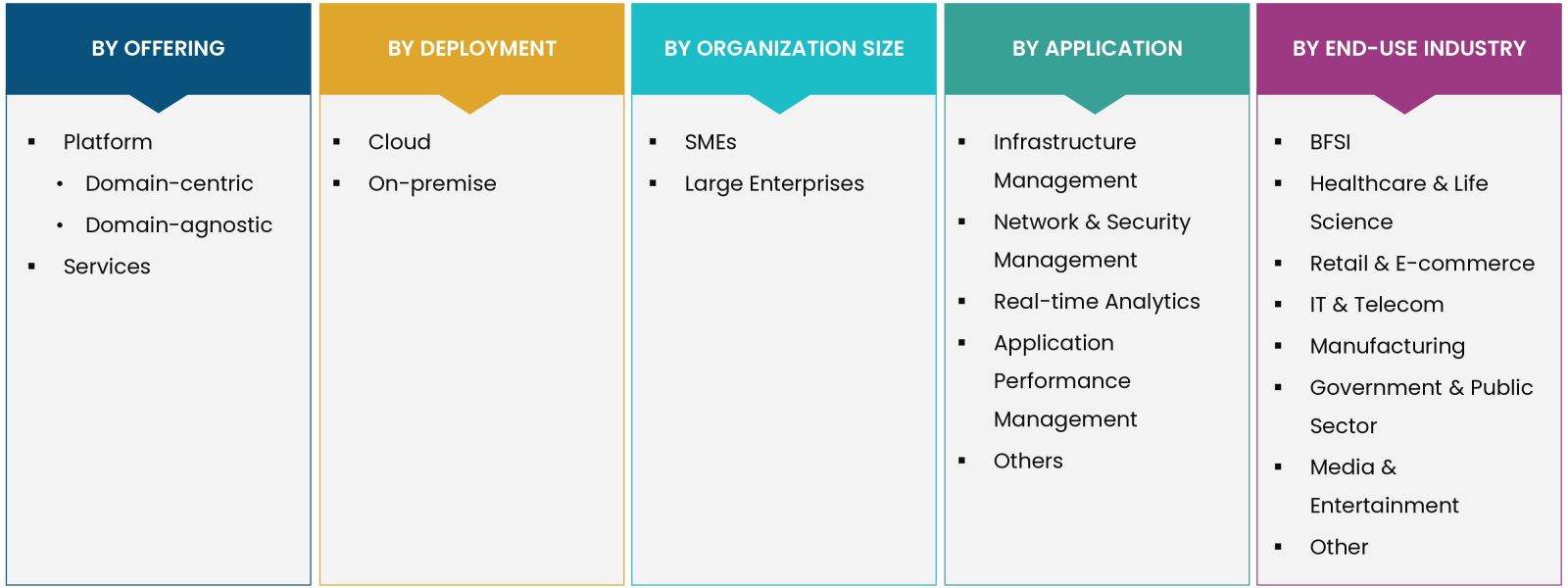
Report Scope:
| Report Features | Description |
|---|---|
| Market Size (2023-e) | USD 10.4 billion |
| Forecast Revenue (2030) | USD 50.1 billion |
| CAGR (2024-2030) | 25.2% |
| Base Year for Estimation | 2023-e |
| Historic Year | 2022 |
| Forecast Period | 2024-2030 |
| Report Coverage | Market Forecast, Market Dynamics, Competitive Landscape, Recent Developments |
| Segments Covered | By Offering (Platform (Domain-centric, Domain-agnostic), Services); By Deployment (Cloud, On-premise); By Organization Size (SMEs Large Enterprises); By Application (Infrastructure Management, Network & Security Management, Real-time Analytics, Application Performance Management, Others); By End-use Industry (BFSI, Healthcare & Life Science, Retail & E-commerce, IT & Telecom, Manufacturing, Government & Public Sector, Media & Entertainment, Other) |
| Regional Analysis | North America (US, Canada), Asia-Pacific (China, Japan, South Korea, India), Europe (Germany, France, UK, Italy), Latin America and Middle East & Africa |
| Competitive Landscape | BMC Software, Broadcom, Cisco, Dynatrace, Elastic, HCL, IBM, Interlink Software, Micro Focus, Moogsoft, NTT Data, OpenText, SolarWinds, Autointelli, BigPanda, CloudFabrix, ManageEngine, Netreo, New Relic, PagerDuty, ProphetStor, Resolve, Sumo Logic, and Zoho |
| Customization Scope | Customization for segments, region/country-level will be provided. Moreover, additional customization can be done based on the requirements. |
| Purchase Options | We have three licenses to opt for Single User License, Multi-User License (Up to 5 Users), Corporate Use License (Unlimited User and Printable PDF) |
|
1.Introduction |
|
1.1.Market Definition |
|
1.2.Scope of the Study |
|
1.3.Key Stakeholders of the Market |
|
2.Research Methodology |
|
2.1.Research Approach |
|
2.2.Data Collection |
|
2.3.Market Assessment |
|
2.4.Assumptions & Limitations for the Study |
|
3.Executive Summary |
|
4.Market Dynamics |
|
4.1.Drivers |
|
4.1.1.Emphasis on Streamlining IT Operations |
|
4.1.2.Growing Demand for Real-time Analytics from Enterprises |
|
4.1.3.To Improve Root Cause Analysis |
|
4.2.Restraints |
|
4.2.1.Lower Accuracy Turn into Slower Adoption |
|
4.2.2.Complexity of IT Infrastructure |
|
4.3.Opportunities |
|
4.3.1.Rising Demand for Automation in Enterprise Operations |
|
4.4.Challenges |
|
4.4.1.Lack of Skilled Professionals |
|
4.4.2.High Volume and Low Quality of Data |
|
4.4.3.Integration with Old Legacy Infrastructure |
|
4.5.Trends |
|
4.5.1.Integration of Low-code No-code Platforms |
|
4.5.2.Integration of Cloud with AIOps and Predictive Analytics |
|
5.Market Outlook |
|
5.1.Stages of AIOps |
|
5.2.Pricing Analysis |
|
5.3.PESTLE Analysis |
|
5.4.PORTER's Five Forces Analysis |
|
5.5.Case Studies |
|
6.Market Size by Offering (Market Size and Forecast by Value - USD billion, 2024 - 2030) |
|
6.1.Platform |
|
6.1.1.Domain-centric |
|
6.1.2.Domain-agnostic |
|
6.2.Services |
|
7.Market Size by Deployment (Market Size and Forecast by Value - USD billion, 2024 - 2030) |
|
7.1.Cloud |
|
7.2.On-premise |
|
8.Market Size by Organization Size (Market Size and Forecast by Value - USD billion, 2024 - 2030) |
|
8.1.SMEs |
|
8.2.Large Enterprises |
|
9.Market Size by Application (Market Size and Forecast by Value - USD billion, 2024 - 2030) |
|
9.1.Infrastructure Management |
|
9.2.Network & Security Management |
|
9.3.Real-time Analytics |
|
9.4.Application Performance Management |
|
9.5.Others |
|
10.Market Size by End-use Industries (Market Size and Forecast by Value - USD billion, 2024 - 2030) |
|
10.1. BFSI |
|
10.2. Healthcare & Life Science |
|
10.3. Retail & E-commerce |
|
10.4. IT & Telecom |
|
10.5. Manufacturing |
|
10.6. Government & Public Sector |
|
10.7. Media & Entertainment |
|
10.8. Other Industries |
|
11.Regional Outlook, (Market Size and Forecast by Value - USD billion, 2024 - 2030) |
|
11.1. North America |
|
11.1.1. US |
|
11.1.1.1. US Market Outlook by Offering |
|
11.1.1.2. US Market Outlook by Deployment |
|
11.1.1.3. US Market Outlook by Organization Size |
|
11.1.1.4. US Market Outlook by Application |
|
11.1.1.5. US Market Outlook by End-use Industries |
|
Note: Similar Cross-segmentation for each country will be covered as shown above |
|
11.1.2. Canada |
|
11.2. Asia-Pacific |
|
11.2.1. China |
|
11.2.2. Japan |
|
11.2.3. South Korea |
|
11.2.4. India |
|
11.3. Europe |
|
11.3.1. UK |
|
11.3.2. Germany |
|
11.3.3. France |
|
11.3.4. Italy |
|
11.4. Latin America |
|
11.5. Middle East & Africa |
|
12.Competitive Landscape |
|
12.1. Market Share Analysis |
|
12.2. Key Market Growth Strategies |
|
12.3. Company Strategy Analysis |
|
12.4. Competitive Benchmarking |
|
13.Company Profile |
|
13.1. BMC Software |
|
13.2. Broadcom |
|
13.3. Cisco |
|
13.4. Dynatrace |
|
13.5. Elastic |
|
13.6. HCL |
|
13.7. IBM |
|
13.8. Interlink Software |
|
13.9. Micro Focus |
|
13.10. Moogsoft |
|
13.11. NTT Data |
|
13.12. OpenText |
|
13.13. SolarWinds |
|
14.Emerging Companies |
|
14.1. Autointelli |
|
14.2. BigPanda |
|
14.3. CloudFabrix |
|
14.4. ManageEngine |
|
14.5. Netreo |
|
14.6. New Relic |
|
14.7. PagerDuty |
|
14.8. ProphetStor |
|
14.9. Resolve |
|
14.10. Sumo Logic |
|
14.11. Zoho |
|
15.Appendix |
Intent Market Research employs a rigorous methodology to minimize residual errors by carefully defining the scope, validating findings through primary research, and consistently updating our in-house database. This dynamic approach allows us to capture ongoing market fluctuations and adapt to evolving market uncertainties.
The research factors used in our methodology vary depending on the specific market being analysed. To begin with, we incorporate both demand and supply side information into our model to identify and address market gaps. Additionally, we also employ approaches such as Macro-indicator Analysis, Factor Analysis, Value Chain-based Sizing, and forecasting to further increase the accuracy of the numbers and validate the findings.
Research Approach
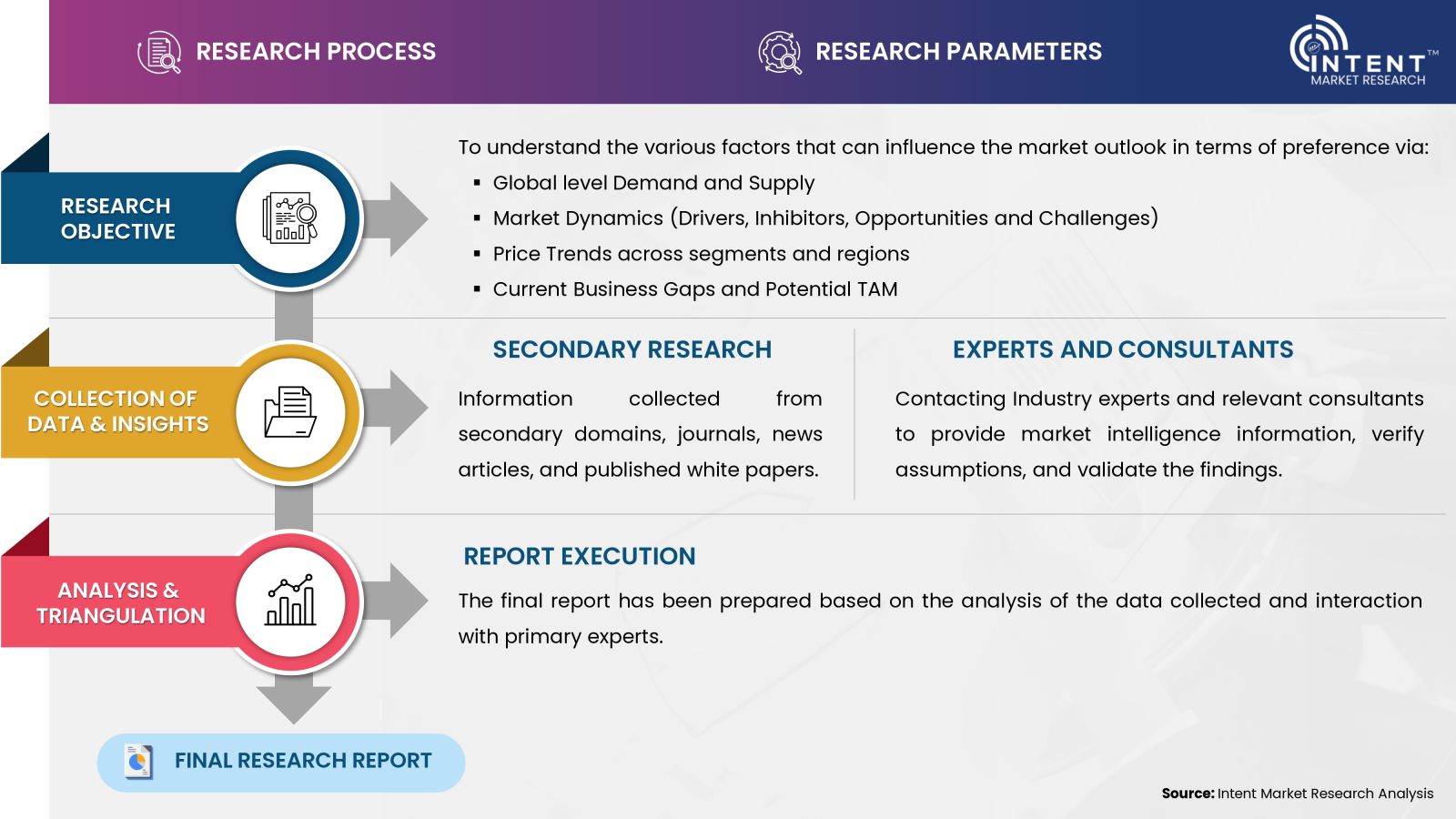
- Secondary Research Approach: During the initial phase of the research process, we acquire and accumulate extensive data continuously. This data is carefully filtered and validated through a variety of secondary sources.
- Primary Research Approach: Following the consolidation of data gathered through secondary research, we initiate a validation process to verify all the market numbers, and assumptions and validate the findings by engaging with subject matter experts.
Data Collection, Analysis and Interpretation:
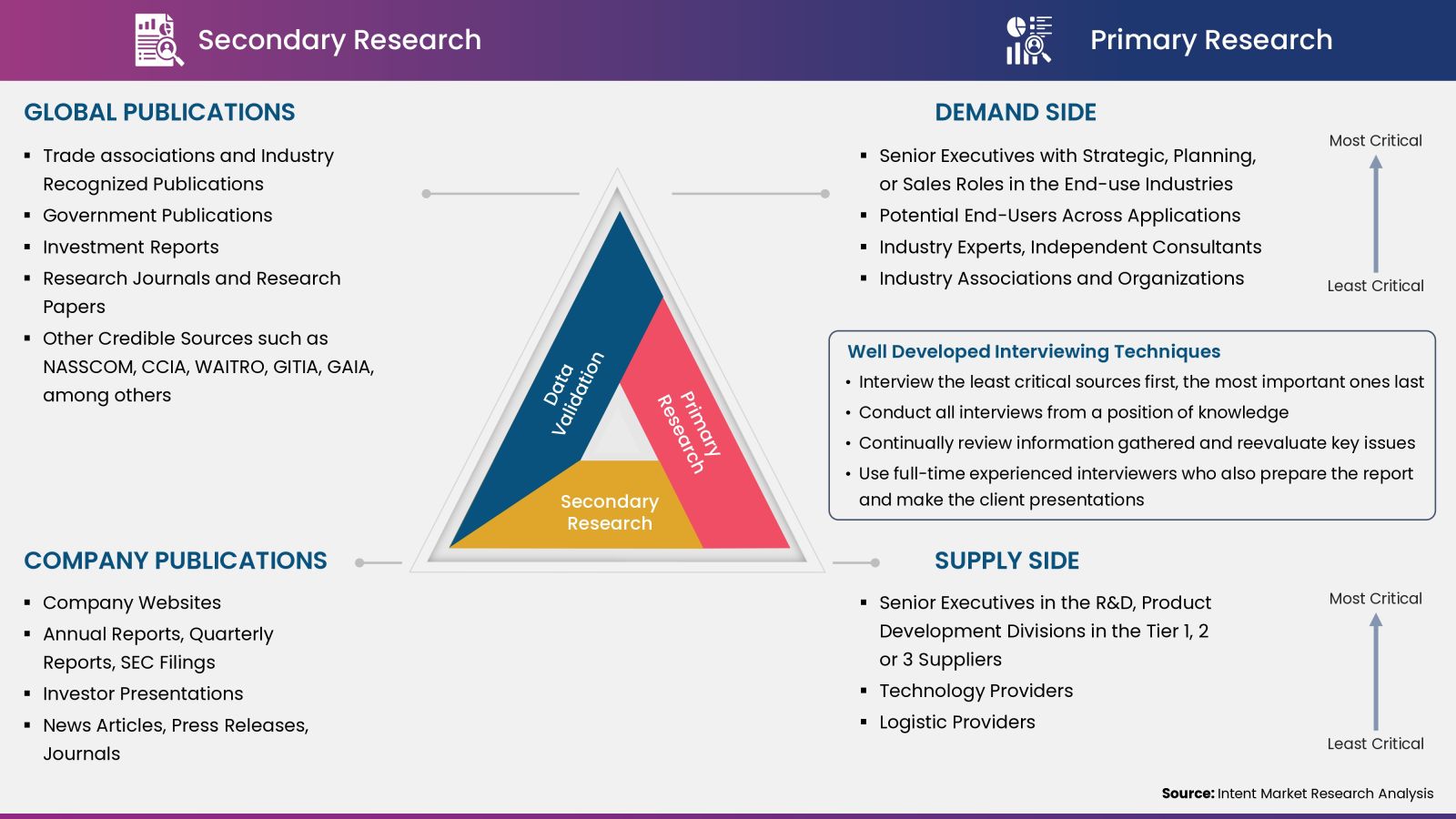
Research Methodology
Our market research methodology utilizes both top-down and bottom-up approaches to segment and estimate quantitative aspects of the market. We also employ multi-perspective analysis, examining the market from distinct viewpoints.
